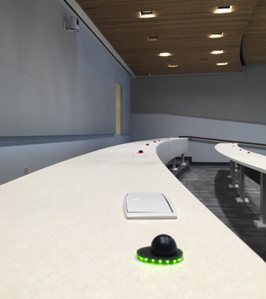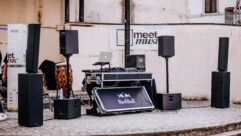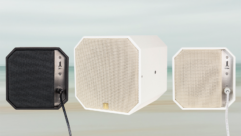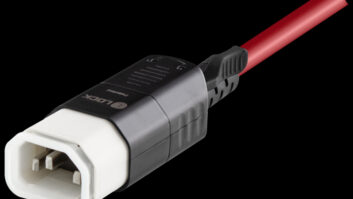
SVC Podcast – Show Notes – Show 164-1
In this edition of the SVC Podcast, SVC Contributing Editor Bennett Liles talks with Thomas DePace of Long Island’s Advance Sound Company. Thomas discusses the AV installation in the new classrooms, labs, telepresence center and multi-use spaces at the Molloy College Barbara H. Hagan Center for Nursing. In Part 1 he tells about the large tiered classrooms and the Clockaudio microphones and Crestron control systems installed in those rooms.
For Part 2
Links of interest:
Download Podcast Here:
https://s3.amazonaws.com/nb-svc/public/public/164-1_Molloy_College_of_Nu…
This is the SVC Podcast from Sound & Video Contractor Magazine with Thomas DePace of Advance Sound Company. Show notes and equipment links for the podcast are on the web site of Sound & Video Contractor Magazine at svconline.com.
When Long Island’s Molloy College got a new building for their nursing program they called in Advance Sound Company to fit out the classrooms, laboratories, meeting rooms and simulation rooms with Clockaudio microphones, Da-Lite projection screens and Crestron control. Thomas DePace is here to tell us how it all got in and set up on time. That’s coming right up on the SVC Podcast.
Thomas, glad to have you with us on the SVC Podcast from Advance Sound Company and I believe you’re on Long Island.
Yes, we are. Thanks for having me.
Molloy College and its new classroom facilities look like a major installation project with some pretty sophisticated AV systems. Before we get into that though how about telling us about Advance Sound Company.
Well, we’re a systems integration firm here on Long Island and we’re celebrating our 45th anniversary this year, so we’ve been around for quite some time. And you know over the past couple of years we’ve really excelled from an audio firm to a true systems integration firm, you know, working on some large-scale projects for K through 12, higher education and corporate work. [Timestamp: 1:26]
And this project was not only sound but video and control, the whole works. It was a brand new building so you got a clean slate with this rather than upgrading an existing facility?
This building was a clean slate right from the steel up. So the nursing program at the school is actually one of the top-rated in the country and they needed a space that echoed the caliber of the program. [Timestamp: 1:48]
And what specific capabilities did Molloy College want to have when this new building was done and the systems were ready to use?
Besides having multifunction use for various other programs in the college they wanted to make sure that the nursing needs were truly met. They have a simulation lab in the building and they wanted to be able to review video and audio from the actual simulations of the SIM modules giving birth or someone being sick and being able to take those and make them teaching experiences and being able to disseminate that information to tiered classrooms as well as just rooms where the doctoral students can meet and speak with industry professionals such as doctors and nurses and paraprofessionals. [Timestamp: 2:35]
OK. Of course there’s always a balance between giving them lots of sophisticated capabilities and making the system operation too complex. Describe the classroom setup for us. It looks like each student has their own mic right in front of them at their desks.
In the tiered classroom it’s really very tech-forward. There’s a Clockaudio microphone for every two seats and that really enhances the collaborative experience in those tired classrooms. That paired with some Axis cameras that track which microphones are on and three projection screens in the room, they’re able to show the actual student projection. They’re able to show a presentation in the classroom as well as some sort of an outside source, whether that’s video conferencing or a collaborative source. [Timestamp: 3:21]
And you put in the control system and everything for this.
Yes. Absolutely.
Crestron?
It was. In the tiered classrooms it’s all led with a PRO3 processor and a DM matrix, but in the regular classrooms in the building they all have a DMPS3-300 that not only deals with the AV automation, but the room environment as well. So it controls the lighting and shades in those rooms. [Timestamp: 3:48]
And you used the Clockaudio C012E-RF I believe with the CH32 base on it?
Yes, we did. In the tiered classrooms they’re probably the most durable, vandal-resistant microphones that we have and then paired with the touch ring it gives the professor or the person leading the lecture the opportunity to see who’s talking, who’s in the queue to talk and it gives them the opportunity to pick people that may not be so apt to talk to speak as part of the presentation as well. So it allows the professor to really immerse the whole class in the teaching experience. [Timestamp: 4:29]
Yeah, it lets them just push a button to get in line to talk. There are plenty of those types of microphones out there. Why did you decide on the Clockaudio mics in particular for this?
There’s tons of microphones in the market, but the durability – it’s not a mesh-frame microphone. It’s a microphone that’s really tested in the corporate environment with CEO’s kind of pushing their pencils and pens. And so in a building that sees so many students we wanted to make sure that for serviceability as well as the quality, I mean, you know, Clockaudio is quality. It’s so repeatable from mic to mic and we knew what we were going to be getting from these microphones. [Timestamp: 5:07]
And of course we talked about the Crestron control system, now what does the interface, the user interface on that look like?
The user interface is custom-designed and we actually story boarded the touch panels with the IT and support staff at the college to make sure it met their needs. And it’s got some quick-start buttons in the beginning where a professor that may not be as tech savvy can come in and push room computer and the screens will come down, the lights will turn off and the room environment will be set. But there’s also some additional controls where the professor can actually choose which people they want to speak and have the layout of the classroom where they can pick specific microphones to turn on. So depending on the comfort level of the professor or someone running a lecture, they’re able to really make the classroom whatever they want it to be. [Timestamp: 5:58]
Yeah, that would be a special challenge in the academic environment I would think because you have such a wide range of tech savviness among the users from people who don’t want to push any buttons to those who might want to customize it for themselves.
Absolutely.
You have to accommodate a very wide range of operators on those systems.
Yeah, definitely.
How are the microphones and cameras coordinated? Is that all automatic or do they have some manual control of the camera?
They do have manual control of the camera. They actually have gesture controls on the touch screens. So in using the Axis V5914 camera not only does it give us an SDI in into the video system, but it also has a camera stream that we’re able to put on the touch panels that they can control. The main use of the cameras, however, is fully automatic with the microphone queues. So when someone is speaking, both the left and right cameras will move towards the individual speaking. And in the tiered classroom there’s even a lecturer camera in the back of the room that even is automatic but the professor or the adjudicator can set that to their podium to the whole front dais; whatever they really want to look at with that. [Timestamp: 7:11]
Well, that’s very good for most of the professors. After they get used to it they’re probably glad that they have some manual control. How does the projection work? Those seem like pretty big rooms.
They’re a big room, but we worked in tandem with the architect in terms of the best placement of the projectors and the screens. So they really sit in the optimal length of the center of the room, so they’re pretty much standard lenses and paired properly with the screen size and the actual screen surface. [Timestamp: 7:40]
They can do video capture and what do they walk away with? Is it filed on the network or saved to a flash drive that they can just carry out?
We actually split the video input into the capture device and we take a video and put it into the Crestron Capture HD where they can walk away with a thumb drive recording of the lecture. And they also have a Magewell HDMI to USB interface in their computers where they use a software called Panopto to stream and capture the lecture on their global education platform. [Timestamp: 8:13]
That’s got to make a big difference between having to sit there and take notes or just walk out with the whole lecture in your hand. It’s a great advantage for the students.
It definitely is. And the professors are really using the Capture HD as a true backup and, you know, we came into the facility and they were familiar with Panopto so we were able to integrate that flawlessly on their network. [Timestamp: 8:35]
And I think you used the Biamp Systems Tesira digital signal processor?
Yeah. So in the tiered classrooms we built it off the server IO platform just because of the IO count. It allowed us to truly tailor the AEC and the output cards. But in the smaller classrooms they’re all paired with either a VI or a TI depending on what the needs of the space are. [Timestamp: 8:56]
Sounds like it would be fun just to get in there and find out what you can do with it. I always encourage faculty members to go in, take their device and test everything out in the room before they have a class sitting there.
Yeah, it’s true.
OK, thanks for being with us for Part 1. It’s Thomas DePace with Advance Sound Company in Long Island and the great new AV system for the Molloy College nursing program. In Part 2 we’ll get into some of the multi-function spaces. It wasn’t just the big classrooms you did in there. Thanks for the details on it.
Sounds good. Thank you.
Thanks to Thomas DePace and to YOU for joining us for the podcast. Show notes and equipment links are on the website of Sound & Video Contractor Magazine at svconline.com. Next week Tom will be back to tell us about the multi-purpose spaces and the AV installation in those. That’s on the next SVC Podcast.










